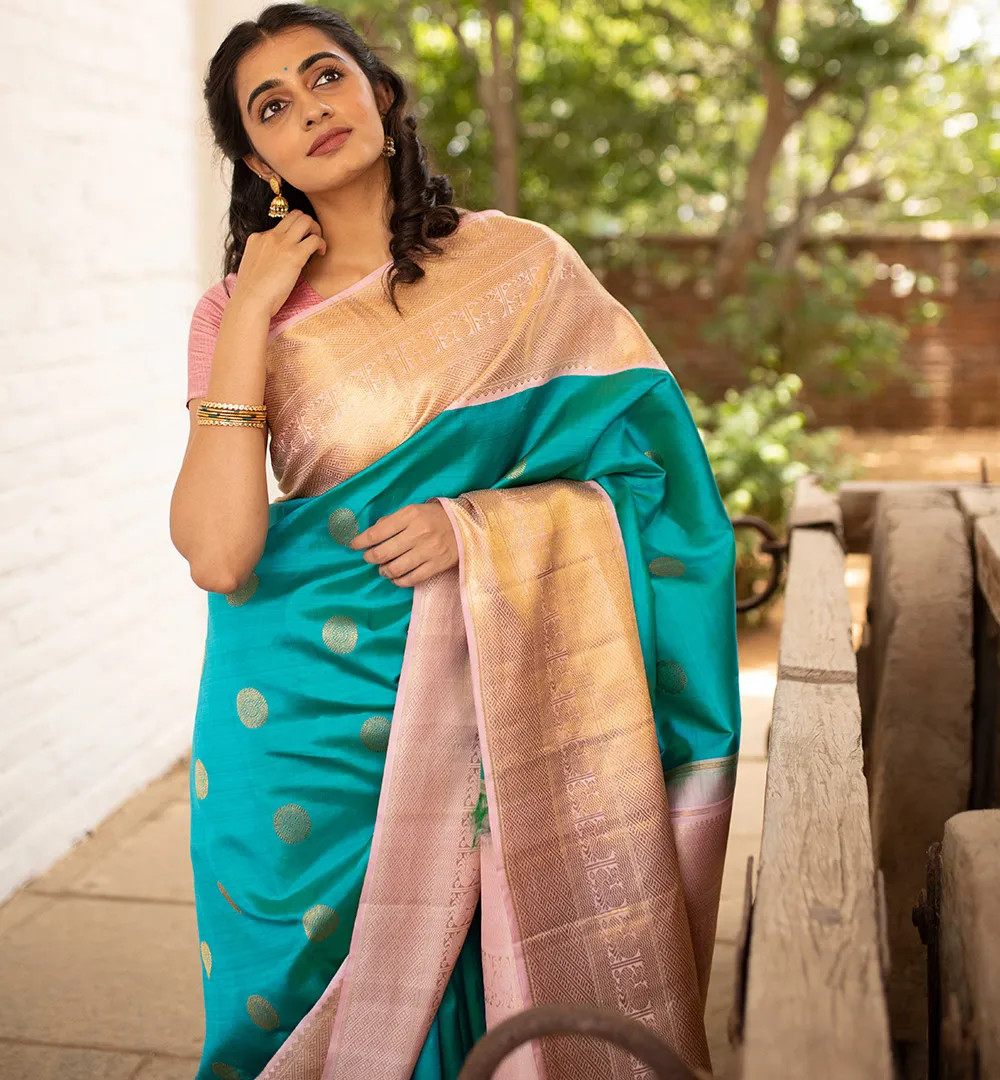Evolution of Sarees in South Indian Weddings
Ever witnessed a south Indian bride making her first entrance and the undeniable smile she puts on the groom's face? It reminds of these lines,
"Thulaa thottil unnai vaithu
Nigar seiya ponnai veithaal
Thulaabaaram thorkaatho
Perazhagae… "
Loosely translating to - Even gold seems invalid when compared to your beauty!
And as she enters, suddenly the lights, flowers, and the sound of nadhaswaram, all seem to fade away. Her smile stays gracious, and her face reflects off the colors she chose to wear. The texture of her silk, the prints, and the seamless zari, everything blends as one with her. She looks like a goddess and such is the craftsmanship, heritage, and years of improvisation behind the making of her bridal drape. Let's talk about this story of the bride, and how her bridal saree evolved through the years to meet her on her beautiful day.
6 Yards of Love - The Origin Story
It all started around the 5th millennium BC when cotton was weaved to create a long robe-like fabric for women to drape. Its origin goes back to the Indus Valley civilization. Talking about humble beginnings, our saree has seen it all!
The Indian weavers then began to use lac, indigo, and turmeric as dyes while industrialization paved the way for synthetic and chemical dyes along with new printing techniques that were earlier unexplored. With the boom of silk exports, regional handloom silks such as the Banarasi, Paithani, Kanjeevaram, Chanderi, Maheshwari, etc. became unstoppable. The inclusion of various stones and precious threads like gold/silver, as we see in today's bridal sarees was the result of the rich making these changes during British rule. Since then, it has been quite a journey for the saree to become the marvel it is today.
Significance of the Bridal Kanjeevaram Pattu
Originating from the temple town of Kanchipuram, this pure mulberry silk is woven into heavenly eternal sarees that eventually become a family heirloom due to its incredible material strength and quality.
The yarn that is first dipped in rice water and sun-dried is then weaved into interlocking metallic yarns such as gold and silver that become the "Zari" part of a saree. Depending on the zari type and the motif design, these sarees are categorized into 4 different types.
- Plain Kanjeevaram with golden zari
- Temple border Kanjeevaram with zigzag zari design
- Traditional Kanjeevaram sarees that follow checkered design for its body, and motif designs predominantly being mangoes, coins, chakra, etc.
- Modern Kanjeevaram silk with a contemporary twist in border designs, material texture and motifs.
How different is a modern-day bridal saree?
With the lockdowns finally over, the Indian wedding industry's been bustling and the bridegrooms are getting more experimental with their creative choices.
The millennial brides show more confidence in dressing up in the way it best represents their inner personality. Hence, they are now bolder, more stylish yet culturally rooted. Let’s look at the top few trends that South brides have happily embraced in recent times:
- Muted Kanjeevarams
Absolutely dominating the wedding scene is the surprisingly serene and muted, gold-toned Kanjeevaram silk sarees that are lightweight, and elegantly body hugging. This fully-worked, pure-soft silk saree has a brocade body with a comparatively simple zari or no zari at all. Paired with the same coloured blouse and designer chokers, this new style allows the bride to shine the most and is a true testament to her beauty.
- Heritage weaves from other states
Cross-cultural heritage weaves like Banarasi, Paithani, Chanderi and tissue silk on a South bride make us believe that there's a saree predestined for every bride. It is as though her name was written on every thread chosen and craftily weaved. These precious handlooms showcasing intricate work and rich zari, in contrast with traditional temple jewellery, are simply a match made in heaven for the auspicious ceremony.
- Family heirloom for the big day
South brides are owning with pride, the vintage saree that's passed down through the years with deliberate care and compassion, as homage towards their family heritage. The saree’s grandeur and artistic value are undisputedly superior in comparison to the modern-day weaves and easily make the most beautiful bride there is.
- Pastels, pink and other soft hues
Minimalism in South Indian weddings is making heads turn and people talk. For the pastels, pinks, ivory and teal are making their way into the bridal fit. Daringly adorable are these brides who changed the decades-old narratives with a fresh, subtle and sophisticated approach. These picturesque brides pair up their soft-tinted sarees with diamond polki jewellery that adds all the zing and haute required for the occasion.
If you want to check out the best-in-town collection of Kanchipurams, then head over to Tulsi Madras for your next draping collectable.


